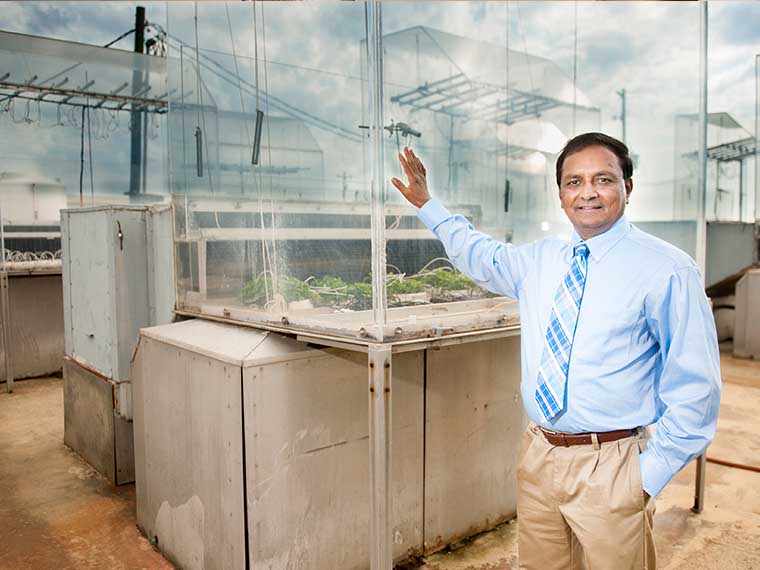The information presented on this page may be dated. It may refer to situations which have changed or people who are no longer affiliated with the university. It is archived as part of Mississippi State University's history.
Situated in the southeast corner of the Mississippi Agricultural and Forestry Experiment Station's R. R. Foil Plant Science Research Center sits one of only a few closed environment plant growth research instruments in the world. It is part of the Soil-Plant-Atmosphere-Research facility (SPAR), designed to determine plant responses to a variety of environmental factors.
The ten sunlit chambers, established in 1977, contain soil bins covered by Plexiglas enclosures measuring over eight feet high, over six feet long, and nearly five feet wide. The units are designed to research environmental plant physiology, evaluating temperature, drought, solar radiation including ultraviolet-B radiation and nutrients, among other variables.
Dr. Raja Reddy, MAFES research professor, is the director of the SPAR facility at MSU. Researchers, which include undergraduate and graduate students, assess how global climate change impacts the biology of crops.
"We screen crop cultivars for abiotic stressors," Reddy said. "We evaluate a hybrid's tolerance to abiotic stresses like drought and temperature and assign a numerical score to each hybrid so farmers will have tools to select a variety based on its tolerance and yield potential in their specific locations."
Scientists monitor 610 various environmental and plant process signals every 10 seconds to develop quantitative data used to model crops under different environmental conditions.
"Many researchers perform stress/no stress experiments with only a few treatments in the field. Other things vary along with those stresses," Reddy said. "In our case, however, we can perform simulations in which all other stresses are eliminated, isolating a single stressor. That is what makes our data set so unique and not easily replicated."
The team works across a wide variety of crops including corn, rice, soybeans, cotton, sweet potatoes, peppers, cowpeas, and more. The laboratory portion of the facility scans roots and performs analysis to estimate the root number, length, volume, and surface area. The scientists also gather information related to plant photosynthesis, evapotranspiration, and other metabolic-related processes.
The data generated from the growth chamber and root analysis are used to develop models to assist farmers in the field. The hypothesis is that plant growth and development and ultimately yield, can be described as a function of the interaction between plant genetics, the environment in which the plant grows, and specific management practices selected by a producer.
"By quantifying the relationship between plants and their environment, we can create tools to help producers make data-driven, informed management decisions based on sound science," Reddy said.
The SPAR unit also includes a pot-culture facility where about 5,000 pots allow scientists to grow plants in a natural environment, but with computer-controlled fertilization and irrigation to study nutrients, water deficits, and more.
Scientists often begin plants in the pot-culture facility and then move them to the chambers, depending on the particular project needs.
Reddy said each growing season encountered by a producer is unique with varying rainfall, temperature, and other weather variables.
"Our research helps farmers optimize production while minimizing the loss caused by environmental stressors," he said. "Ultimately, we want to help farmers increase yields and profitability to feed a growing population."
Find our more about the SPAR unit at www.spar.msstate.edu.

